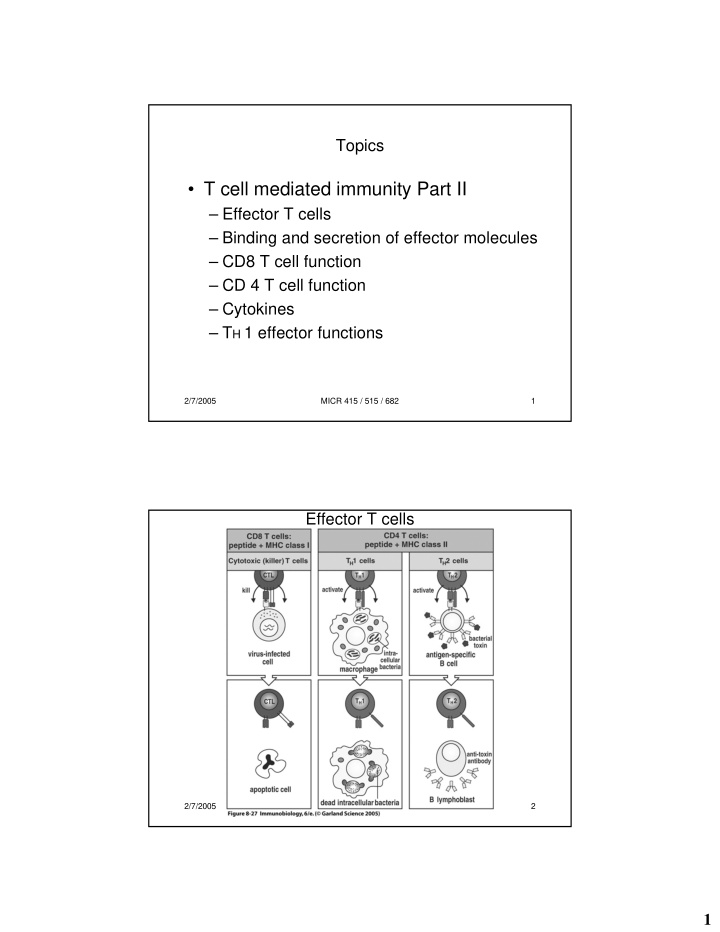



Topics • T cell mediated immunity Part II – Effector T cells – Binding and secretion of effector molecules – CD8 T cell function – CD 4 T cell function – Cytokines – T H 1 effector functions 2/7/2005 MICR 415 / 515 / 682 1 Effector T cells 2/7/2005 MICR 415 / 515 / 682 2 1
•Adhesion molecules allow for longer cell-cell interaction •CD4 cells bind to target cells for a long time •CD8 T cells bind to targets cells for short periods, kills target cell, then detaches and binds to another cell 2/7/2005 MICR 415 / 515 / 682 3 – Binding leads to clustering of receptors – Polarization: 1. Reorganization of cortical actin cytoskeleton at site of contact 2. Reorientation of microtubule reorganizing center 3. Relocalization of Golgi apparatus 4. Exocytosis at site of contact (tight x space) – Detachment Fig 8.28 2/7/2005 MICR 415 / 515 / 682 4 2
Two types of effector molecules: 1. Cytotoxins 2. Cytokines Fig 8.28 2/7/2005 MICR 415 / 515 / 682 5 Cytotoxins – Soluble secreted factors 1. perforin 2. granzyme – Membrane associated factors 1. Fas Ligand 2/7/2005 MICR 415 / 515 / 682 6 3
Cytokines • Small secreted soluble molecules that can change the behavior or properties of the cell itself or of another cell • Multiple effects in different types of cells • Synergism • Lymphocytes = lymphokines • T cell = Interleukines • Chemoattractants = chemokines • Studied by in vitro assays or gene disruption 2/7/2005 MICR 415 / 515 / 682 7 Types of effector T cells CTL Cytotoxic T cells CD8 Th1 MHC I recognition CD4 Kill viral infected cells MHC II recognition Kill Transformed cells Activation of macrophages Th2 CD4 MHC II recognition Activation of B cells 2/7/2005 MICR 415 / 515 / 682 8 4
Effector Molecules 2/7/2005 MICR 415 / 515 / 682 9 CD8 T cells 2/7/2005 MICR 415 / 515 / 682 10 5
The kiss of death 2/7/2005 MICR 415 / 515 / 682 11 CTL effector molecules • Perforin: forms a pore in membrane • Granzymes: Serine proteases, activate apoptosis • Fas ligand: activates apoptosis • IFN- γ : inhibits viral replication, up-regulate MHC I expression, activates macrophages • TNF- α TNF- β : synergizes with IFN- γ , induce apoptosis 2/7/2005 MICR 415 / 515 / 682 12 6
Cytotoxic T cells are selective 2/7/2005 MICR 415 / 515 / 682 13 CD4 T cells T H 0 T H 1 & T H 2 2/7/2005 MICR 415 / 515 / 682 14 7
Differentiation of CD4 cells Initial response • mounted by the innate non-specific immune response is important in this process 1. Cytokines elicited by infectious agents 2. Molecules used for co- stimulation 3. Nature of MHC:peptide ligand 2/7/2005 MICR 415 / 515 / 682 15 Main Th1 cytokines • IL-2 (Th 0, Th1, CTL) – Growth of T cells – Growth of NK cells • IFN- γ (Th1, CTL) – Increase MHC I & II – Inhibits Th2 cell growth – Activates macrophages – B cell differentiation, IgG2a synthesis – Activates NK cells Figure 8:31, appendix 2 2/7/2005 MICR 415 / 515 / 682 16 8
Main Th2 cytokines • IL-4 (Th2) – B cell activation and growth – Th2 growth and survival – Increase MHC II – IgG1, IgE – Decreases macrophage activation • IL-5 (Th2) – IgA – increase eosinophils • IL-10 (Th2) – Increase MHC II – Inhibit Th1 cell growth 2/7/2005 MICR 415 / 515 / 682 17 other cytokines • IL-3 (Th1, Th2, CTL) – Stimulates hematopoiesis • TNF- α (Th1, some Th2, CTL) – Activates macrophages (synergy with IFN- γ ) – production of NO • GM-CSF (Th1, Th2, CTL) – Increase granulocyte production – Increase macrophage and dendritic cell production 2/7/2005 MICR 415 / 515 / 682 18 9
2/7/2005 MICR 415 / 515 / 682 19 2/7/2005 MICR 415 / 515 / 682 20 10
2/7/2005 MICR 415 / 515 / 682 21 Consequences of Th1 or Th2 Leishmania sp Th1 Th2 Anti-IL-4 IL-4 Resistant Susceptible Th 2 Th1 Susceptible Resistant 2/7/2005 MICR 415 / 515 / 682 22 11
Macrophage activation • Requires 2 signals: • IFN -gamma • CD40 or • membrane bound TNF alpha or beta • Stimulation via TCR triggers novo protein synthesis • Proteins are delivered to the site of contact by vesicles • Signals are delivered directly to that macrophage 2/7/2005 MICR 415 / 515 / 682 23 Activated macrophage 1. Increase fusion of lysosomes and phagosomes to form phagolysosomes 2. Increase oxygen radicals and Nitric Oxide production 3. Increase expression of B7, CD40, MHC II & TNF receptors 4. Production of IL-12 (stimulates Th1 cells) 5. Recruitment of other cells 6. More effective killing 7. Better APC 2/7/2005 MICR 415 / 515 / 682 24 12
2/7/2005 MICR 415 / 515 / 682 25 2/7/2005 MICR 415 / 515 / 682 26 13
2/7/2005 MICR 415 / 515 / 682 27 14
Recommend
More recommend